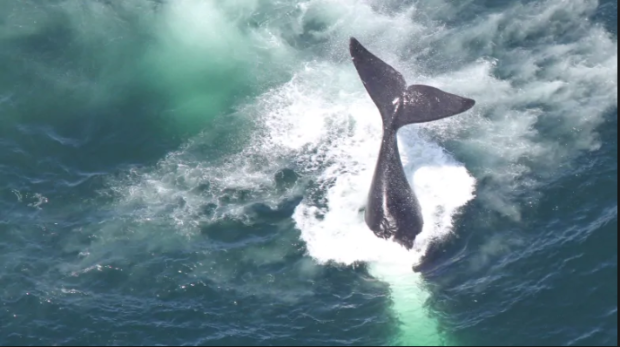Rescuers partially free 2 out of 3 entangled right whales in Gulf of St. Lawrence
A whale rescue team in New Brunswick has partially freed two out of three North Atlantic right whales in the Gulf of St. Lawrence.
The rescuers, who had been kept ashore by difficult weather conditions, went back into the Gulf of St. Lawrence on Tuesday after two of the three entangled whales were spotted during an aerial surveillance flight.
Whale 4423, a five-year-old male, was spotted around 11 a.m. by a surveillance flight. Last Thursday, the team from Campobello Island had been able to remove fishing gear keeping the whale from using its tail when diving, but some gear remained after the rescue was interrupted by dusk.
On Tuesday, more progress on freeing the whale was made, the Department of Fisheries and Ocean said in a statement.
"Additional cuts were made to the gear, and although unable to completely free the whale, these additional cuts appear to have shifted the gear configuration on the whale, which could mean it is lightening up," the statement said.
The whale was first spotted entangled July 4, east of Miscou Island in northeastern New Brunswick. Initial reports indicated the whale could be the same entangled animal that was spotted in U.S. waters in April.
Shortly before 5 p.m. Tuesday, North Atlantic right whale 4440, another five-year-old male, was spotted in the gulf. The rescue team was able to cut the rope from the whale's mouth to its tail.

"It was not possible to completely remove the gear," DFO said.
This entangled whale was first seen on June 29, also east of Miscou Island. The whale was spotted again July 2 and July 5, when it appeared to be dragging something heavy around its tail stock.
"The next step for both these whales will be to assess, by air, how the entanglement configuration has changed after today's work," DFO said.
Rescue is weather dependent
The department said efforts to free all three entangled whales will resume when weather permits.
The Department of Fisheries and Oceans, the whale rescue team, and the U.S. National Oceanic and Atmospheric Administration, or NOAA, were all part of Tuesday's rescue mission.
Since April, the Canadian government has spent more than 1,150 hours in the air monitoring North Atlantic right whales. The work includes flights by conservation and protection services, DFO science aircraft and the Transport Canada's National Aerial Surveillance Program.
Earlier this month, Transport Canada announced additional measures to protect the endangered whales from fatal ship strikes and entanglement in fishing gear.
The department said it will keep the measures in place until at least July 22, "while continuing to evaluate actions to protect the North Atlantic right whales."
The measures include further reductions in ship speeds in the area, expansion of the zones in which the speed restrictions apply and increased aerial surveillance.
Meanwhile, NOAA announced a voluntary vessel speed restriction zone, which has been established south of Nantucket, of Cape Cod in Massachusetts. The restriction was announced after right whales were observed in the area on Monday.

